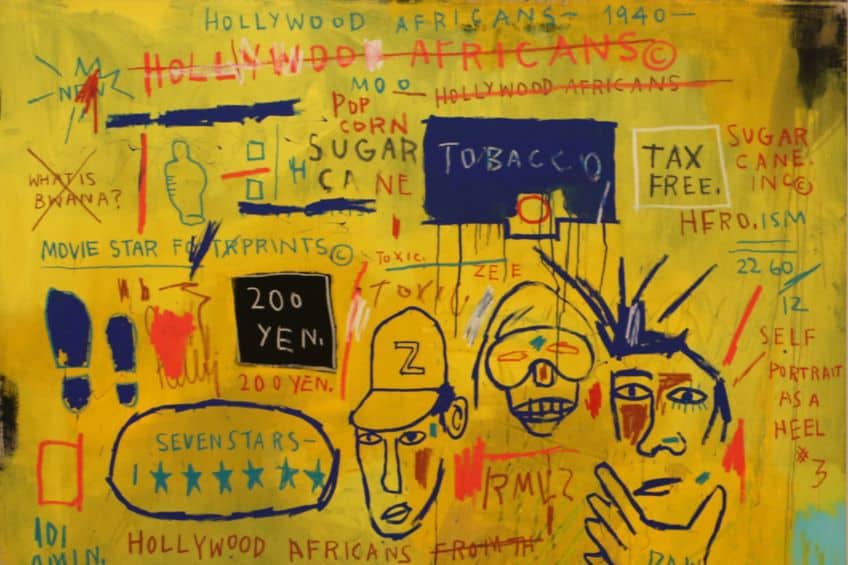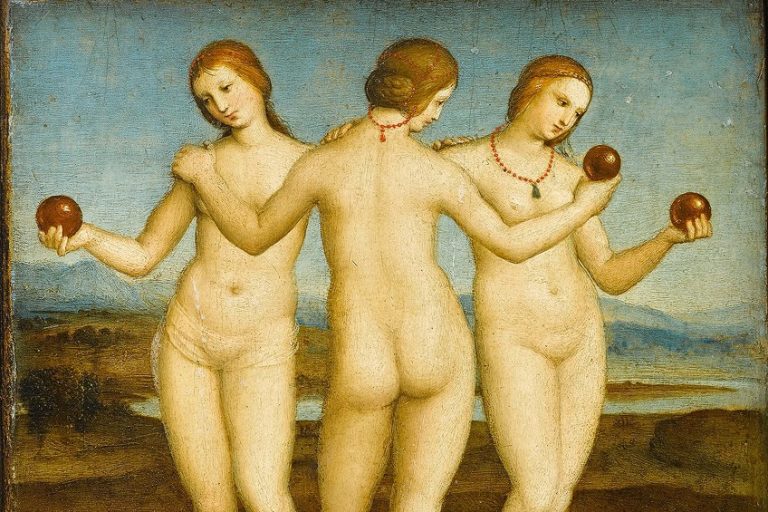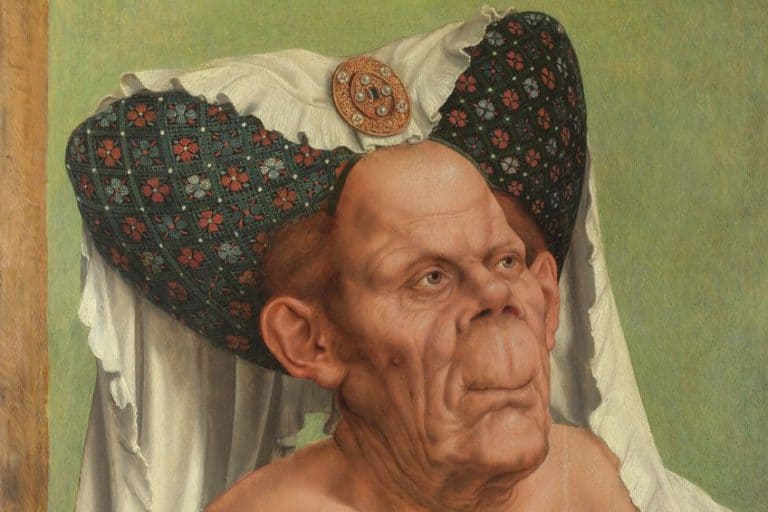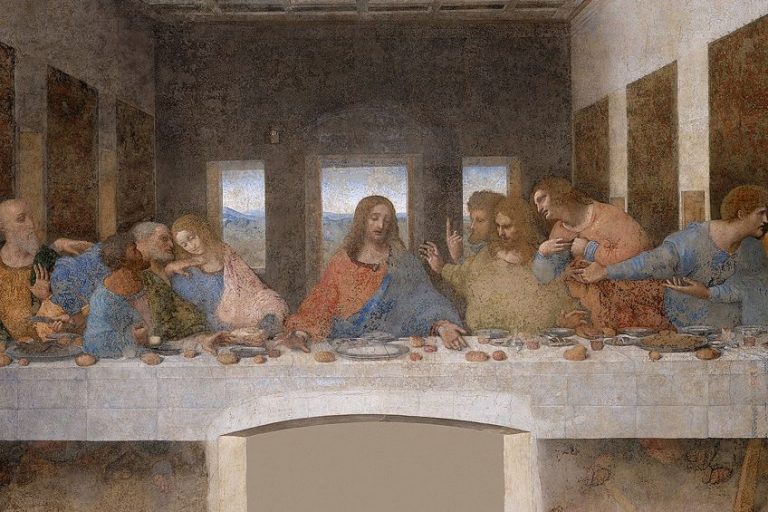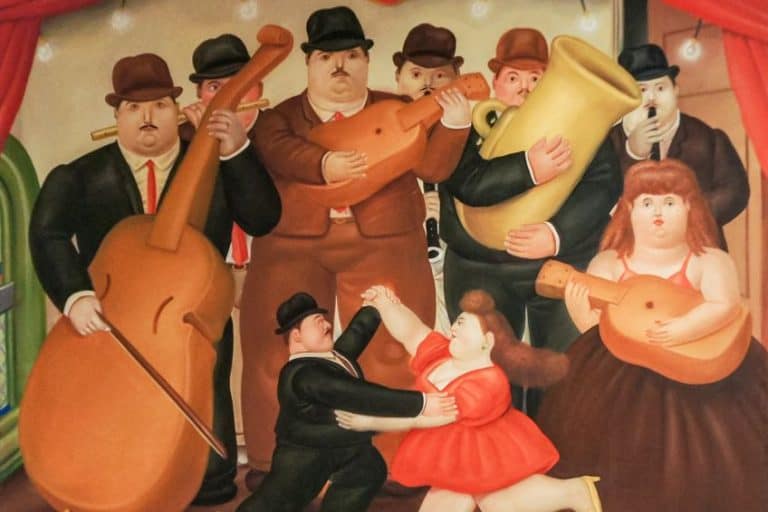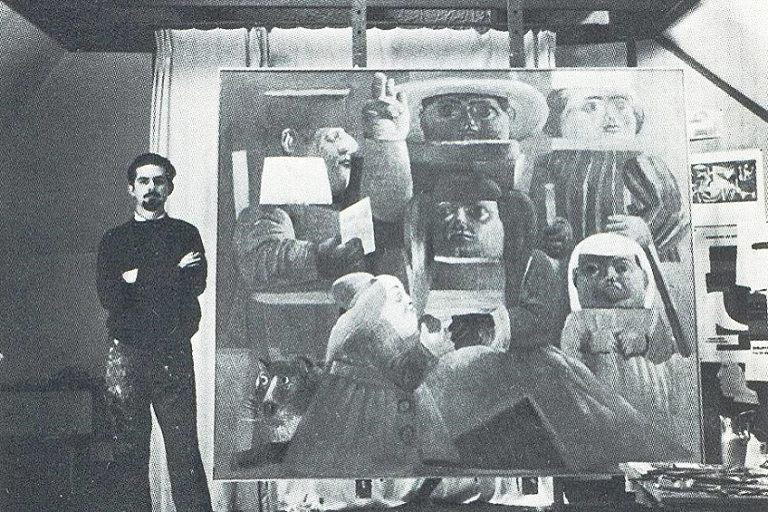“Hollywood Africans” by Jean-Michel Basquiat – A Painting Analysis
Hollywood Africans by Jean-Michel Basquiat, created in 1983, is a powerful and thought-provoking piece that reflects the artist’s critical examination of racial stereotypes and the entertainment industry’s portrayal of African Americans. This vibrant and complex painting features Basquiat himself alongside artist friends Toxic and Rammellzee, surrounded by a mix of text, symbols, and vivid colors. The work’s layered imagery and inscriptions, such as “gangsterism” and “sugar cane,” serve as a commentary on the marginalization and commodification of black culture in Hollywood. Through Hollywood Africans, Basquiat boldly challenges societal perceptions and asserts the presence and significance of African American identity in contemporary art and media.
Key Takeaways
- Hollywood Africans is a 1983 painting by Jean-Michel Basquiat.
- The painting critiques racism and stereotypes in the entertainment industry.
- Basquiat’s work remains influential in contemporary art.
Context of Creation
| Artist | Jean-Michel Basquiat (1960 – 1988) |
|---|---|
| Date Created | 1983 |
| Medium | Acrylic and oil stick on canvas |
| Genre | Neo-Expressionism |
| Period/Movement | Contemporary Art |
| Dimensions (cm) | 213.5 × 213.4 |
| Series/Versions | Single version |
| Where Is It Housed? | Whitney Museum of American Art, New York City, United States |
| What It Is Worth | Estimated to be worth millions; significant cultural and historical value |
Jean-Michel Basquiat’s Hollywood Africans, created in 1983, stands as a powerful piece reflecting significant themes such as racism, social critique, and autobiographical elements. Painted with acrylic and crayon on canvas, this work of art measures 213.5 cm by 213.4 cm and showcases Basquiat’s Neo-Expressionist style. It has found a permanent home at the Whitney Museum of American Art.

Born in Brooklyn, New York, Basquiat incorporated his Haitian and Puerto Rican heritage into his work, presenting a unique perspective on the African American experience. Hollywood Africans provides a raw commentary on the stereotypes and treatment of African Americans in the entertainment industry. The painting includes vivid imagery, symbolic figures, and bold text, making it a visually captivating and thought-provoking piece. The significance of Hollywood Africans extends beyond its visual appeal. The use of vibrant colors and chaotic composition reflects Basquiat’s inner turmoil and his fight against societal issues.
This painting not only cements his position in the art world but also continues to influence and inspire contemporary artists interested in addressing similar themes.
Influences on Basquiat’s Work
Basquiat’s work was deeply influenced by street culture and graffiti, which he first explored in New York. In the late 1970s, he began creating graffiti under the pseudonym SAMO. These early experiences shaped his raw, expressive style. Neo-Expressionism also had a significant impact on his work. This movement emphasized vivid colors and emotional intensity, which can be seen in Hollywood Africans. His friendship with Andy Warhol pushed him to explore themes of popular culture and social criticism. The visit to Los Angeles brought new inspiration. The contrast between his experiences in both cities added depth to his critiques of society and culture.

New York Art Scene
The New York art scene played a crucial role in Basquiat’s development. During the early 1980s, the city was a hub for avant-garde and contemporary art. Basquiat quickly made a name for himself in this environment. He initially gained attention through the graffiti scene, but his transition to gallery painting allowed him to reach a broader audience. New York was home to influential artists, curators, and collectors who appreciated his innovative style. His association with artists like Andy Warhol boosted his popularity.
The collaboration between Warhol and Basquiat was particularly noteworthy, blending Warhol’s pop art with Basquiat’s expressive techniques to create unique, impactful pieces.
Analysis of Hollywood Africans
Hollywood Africans by Jean-Michel Basquiat is a piece that explores themes of race, identity, and the stereotypes faced by African Americans in the entertainment industry. Through the use of color, line, and symbolic imagery, Basquiat’s work provides a compelling commentary on these issues.

Subject Matter
The painting features three central figures: Jean-Michel Basquiat himself, along with friends and fellow artists Rammellzee and Toxic. These figures represent the presence of Black creatives in a predominantly white entertainment industry. Basquiat uses this trio to highlight his own journey and the struggles shared by many African American artists.
The painting is filled with various texts and symbols, adding layers of meaning that critique stereotypes and commercialism.

Use of Color and Line
Basquiat employs a golden yellow background to make the figures and symbols stand out. The figures are outlined in stark, dark lines, which makes them pop against the backdrop. This use of color and line draws the viewer’s attention to the figures and the text scattered throughout the piece.
The contrasting colors and bold lines create a sense of urgency and highlight the tension between the figures and their environment.

Portrayal of African Americans
The figures in Hollywood Africans are depicted in a stylized, almost caricature-like manner. This portrayal underscores the stereotypes often imposed on African Americans in media. By depicting himself and his friends, Basquiat also comments on the exclusion and marginalization of Black people.
The text around the figures includes references to stereotypical roles like “mammy” and the historic marginalization exemplified by figures like Hattie McDaniel, who was the first Black person to win an Oscar, yet often played such roles.

Symbolism and Commentary
Basquiat fills the painting with textual and visual elements that serve as symbols. The numbers “12, 22, 60” represent his birthdate, grounding the piece in personal history. Texts like “sugar cane” and “tobacco” allude to slavery and consumerism, while the word “gangsterism” critiques the criminal stereotypes placed on African Americans.
This layering of symbols provides a nuanced commentary on race, identity, and the systemic racism that pervades society and the entertainment industry.
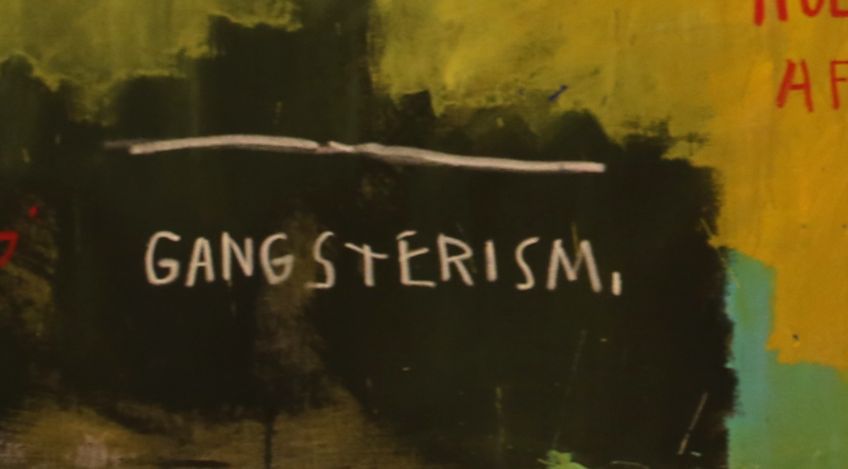
Artistic Techniques
Basquiat’s techniques include the use of acrylic, oil stick, and crayon to create texture and depth. The mix of materials adds to the chaotic and raw aesthetic of the piece. His use of graffiti-like text and vibrant, unblended colors contributes to the Neo-Expressionist style. This style allows Basquiat to communicate complex ideas through a seemingly disordered yet deliberate visual language.
This has the effect of making each element of the painting vital to its overall impact.

Basquiat’s Legacy and Influence
Jean-Michel Basquiat’s impact on the art world remains profound. His work continues to influence modern art and is frequently exhibited and recognized globally. Jean-Michel Basquiat’s art has had a lasting impact on modern art. His unique style blends graffiti with fine art, using bold colors and symbolic language. Artists today often draw inspiration from his fusion of text and image. Basquiat’s work challenges racial stereotypes and addresses social issues. His pieces like Hollywood Africans highlight African American contributions and struggles in the entertainment industry. His influence extends to street art, with many contemporary street artists adopting his methods.
The raw energy and expressive quality of his work continue to inspire new generations of artists worldwide.
Exhibitions and Recognition
Basquiat’s work is regularly showcased in prestigious galleries and museums. The Whitney Museum of American Art and the Brooklyn Museum frequently exhibit his pieces. The Gagosian Gallery has also held several shows featuring his art. These exhibitions help to preserve and promote his legacy. His painting, Untitled, sold for $110.5 million in 2017, demonstrating his enduring value in the art market. This sale solidified his position as one of the leading figures in contemporary art. Basquiat’s work is celebrated not just in the US, but globally, with exhibitions in places like West Hollywood and beyond. His influence on art and culture remains undeniable.

Jean-Michel Basquiat’s Hollywood Africans remains a seminal work that encapsulates the artist’s incisive critique of racial stereotypes and the pervasive impact of Hollywood’s representation of African Americans. By integrating text, symbolism, and personal imagery, Basquiat not only underscores the cultural and historical implications of these portrayals but also reclaims and redefines black identity within the art world. Hollywood Africans continues to resonate with audiences today, serving as a poignant reminder of the ongoing struggles for racial equity and the enduring power of art to challenge and transform societal narratives. Through this piece, Basquiat’s legacy as a trailblazer in contemporary art and a voice for marginalized communities is undeniably solidified.
Frequently Asked Questions
What Themes Does Jean-Michel Basquiat Address in Hollywood Africans?
Basquiat addresses stereotypes about African Americans in the entertainment industry. He examines how these stereotypes impact African American identity and culture.
How Does Hollywood Africans Reflect Jean-Michel Basquiat’s Views on Race and Identity?
The artwork reflects Basquiat’s critique of how African Americans are portrayed in media. It highlights his frustration and aims to challenge the viewer’s perceptions about race and identity.
What Are the Notable Visual Elements Used in Hollywood Africans?
Basquiat uses bright colors and bold text in the painting. He incorporates symbols and figures to convey deeper meanings. Notable elements include the use of yellow, turquoise, and black colors.
What Is the Historical Context Behind the Creation of Hollywood Africans?
Hollywood Africans was created in 1983 when Basquiat visited Los Angeles. It was a time when African American artists faced significant challenges in the industry. The painting reflects the social and cultural issues of that era.
Isabella studied at the University of Cape Town in South Africa and graduated with a Bachelor of Arts majoring in English Literature & Language and Psychology. Throughout her undergraduate years, she took Art History as an additional subject and absolutely loved it. Building on from her art history knowledge that began in high school, art has always been a particular area of fascination for her. From learning about artworks previously unknown to her, or sharpening her existing understanding of specific works, the ability to continue learning within this interesting sphere excites her greatly.
Her focal points of interest in art history encompass profiling specific artists and art movements, as it is these areas where she is able to really dig deep into the rich narrative of the art world. Additionally, she particularly enjoys exploring the different artistic styles of the 20th century, as well as the important impact that female artists have had on the development of art history.
Learn more about Isabella Meyer and the Art in Context Team.
Cite this Article
Isabella, Meyer, ““Hollywood Africans” by Jean-Michel Basquiat – A Painting Analysis.” Art in Context. June 25, 2024. URL: https://artincontext.org/hollywood-africans-by-jean-michel-basquiat/
Meyer, I. (2024, 25 June). “Hollywood Africans” by Jean-Michel Basquiat – A Painting Analysis. Art in Context. https://artincontext.org/hollywood-africans-by-jean-michel-basquiat/
Meyer, Isabella. ““Hollywood Africans” by Jean-Michel Basquiat – A Painting Analysis.” Art in Context, June 25, 2024. https://artincontext.org/hollywood-africans-by-jean-michel-basquiat/.


